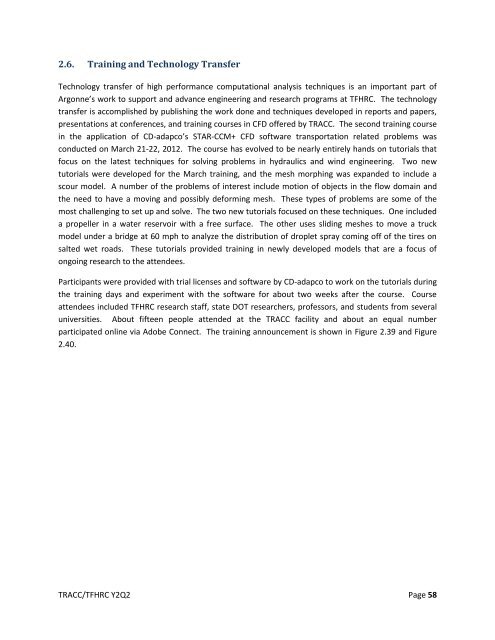Computational Mechanics Research and Support for Aerodynamics ...
Computational Mechanics Research and Support for Aerodynamics ...
Computational Mechanics Research and Support for Aerodynamics ...
- No tags were found...
Create successful ePaper yourself
Turn your PDF publications into a flip-book with our unique Google optimized e-Paper software.
2.6. Training <strong>and</strong> Technology Transfer<br />
Technology transfer of high per<strong>for</strong>mance computational analysis techniques is an important part of<br />
Argonne’s work to support <strong>and</strong> advance engineering <strong>and</strong> research programs at TFHRC. The technology<br />
transfer is accomplished by publishing the work done <strong>and</strong> techniques developed in reports <strong>and</strong> papers,<br />
presentations at conferences, <strong>and</strong> training courses in CFD offered by TRACC. The second training course<br />
in the application of CD-adapco’s STAR-CCM+ CFD software transportation related problems was<br />
conducted on March 21-22, 2012. The course has evolved to be nearly entirely h<strong>and</strong>s on tutorials that<br />
focus on the latest techniques <strong>for</strong> solving problems in hydraulics <strong>and</strong> wind engineering. Two new<br />
tutorials were developed <strong>for</strong> the March training, <strong>and</strong> the mesh morphing was exp<strong>and</strong>ed to include a<br />
scour model. A number of the problems of interest include motion of objects in the flow domain <strong>and</strong><br />
the need to have a moving <strong>and</strong> possibly de<strong>for</strong>ming mesh. These types of problems are some of the<br />
most challenging to set up <strong>and</strong> solve. The two new tutorials focused on these techniques. One included<br />
a propeller in a water reservoir with a free surface. The other uses sliding meshes to move a truck<br />
model under a bridge at 60 mph to analyze the distribution of droplet spray coming off of the tires on<br />
salted wet roads. These tutorials provided training in newly developed models that are a focus of<br />
ongoing research to the attendees.<br />
Participants were provided with trial licenses <strong>and</strong> software by CD-adapco to work on the tutorials during<br />
the training days <strong>and</strong> experiment with the software <strong>for</strong> about two weeks after the course. Course<br />
attendees included TFHRC research staff, state DOT researchers, professors, <strong>and</strong> students from several<br />
universities. About fifteen people attended at the TRACC facility <strong>and</strong> about an equal number<br />
participated online via Adobe Connect. The training announcement is shown in Figure 2.39 <strong>and</strong> Figure<br />
2.40.<br />
TRACC/TFHRC Y2Q2 Page 58

















